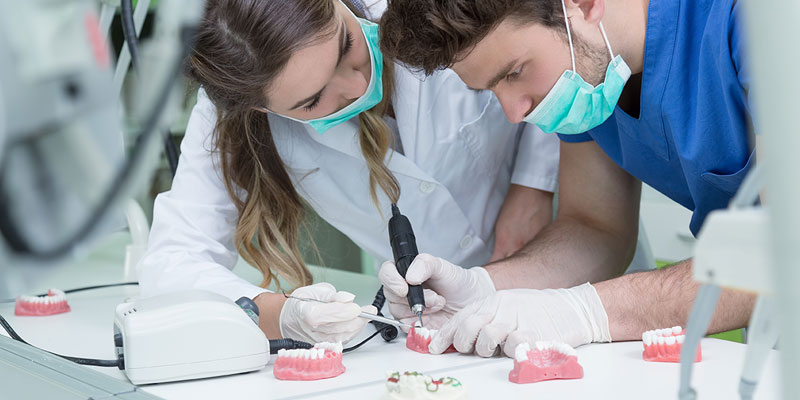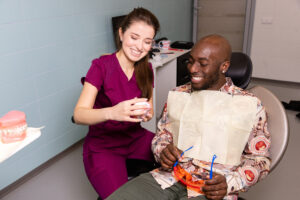- What is an open bite?
- What causes open bite?
- Open bite treatment plan options
- Outcomes from treating open bite
Your dentist is your best partner in helping you achieve and maintain optimum oral health and a smile you can be proud of.
As part of a routine dental checkup, dentists will look for dental issues such as malocclusions, which means the teeth aren’t aligned correctly when the jaws are closed. You may have heard of some of the more common types of malocclusions, such as overbites, underbites, and crossbites.
However, an open bite is another malocclusion that your dentist will check for, especially in children as their teeth are developing.
What is an open bite?
An open bite is a relatively rare type of dental malocclusion. Having an anterior open bite means that your front teeth are angled forward and slanted downward. This results in the upper and lower teeth not touching when the mouth is closed, leaving the bite “open”.
A posterior open bite is similar to the anterior type; however, it affects the back teeth, including the molars and premolars. A posterior open bite means that these teeth do not touch when you bite down, leaving the bite in the back of your mouth open.
In both cases, an open bite leaves a gap in your upper and lower jaw, which can negatively impact your smile and result in:
- Difficulty biting, chewing, or swallowing food
- Pain while biting or chewing food
- A lisp or other speech impediments
- A less-pronounced chin
You might be wondering how an open bite develops. Although genetics can play a role, it has to do with the behaviours of the individual in most cases.
What causes open bite?
These are the most common causes of this type of dental malocclusion:
- Pacifier or thumb sucking: Babies and infants have a natural tendency to suck, and sucking their thumb or on a pacifier can fulfill this need. However, this can also strain the alignment of their teeth, possibly leading to an open bite.
- Sucking the lower lip: Children continually sucking their lower lip between the upper and lower teeth can also strain tooth alignment, resulting in an open bite.
- Thrusting the tongue: When a person pushes their tongue against or between their upper and lower front teeth when speaking, swallowing, or at rest, they can cause an open bite to occur.
- Temporomandibular joint disorder (TMD): People affected by this disorder suffer from chronic jaw pain. They tend to use their tongue to push their teeth apart and reposition their jaw to alleviate discomfort. This action can lead to an open bite.
- Genetics: An open bite can occur through simple genetics, known as a skeletal open bite. A skeletal open bite occurs when the jaws grow apart instead of parallel to one another.
Open bite is treatable at any age, but it’s much easier and more comfortable for the patient to be treated before the permanent teeth are fully grown.
Open bite treatment plan options
There are several corrective treatment options available to solve an open bite. However, the dentist will make recommendations based on the person’s age and whether they have baby teeth or fully developed adult teeth.
Children diagnosed with an open bite will usually start treatment at around seven years of age, while they still have some baby teeth. Treatment can be more complicated for adults and may require a combination of behavioural modifications and orthodontic treatment. In some cases, adults may even require jaw surgery.
Open bite treatment options include:
- Behaviour modification: For children who suck on their thumb, pacifier, or other objects, this behaviour generally stops on its own. However, should the behaviour continue past the ages of two or three, speak to your child’s doctor, pediatrician, or dentist for advice on the best strategies to change these habits.
- Dental appliances: A plastic roller appliance can be used to limit the tongue’s ability to push or come between the front teeth, correcting poor tongue posture. Special headgear can also be worn in conjunction with headgear that uses pressure to move the jaws into the correct position for properly aligned development.
- Orthodontic treatment: Your dentist may recommend orthodontic treatment using traditional braces if the adult teeth are growing into an open bite. These appliances will pull the teeth back into alignment by moving the upper back teeth up, the front teeth down, or both to correct the condition. Once the braces are removed, a retainer is worn to hold the permanent teeth in place.
- Invisalign treatment: Invisalign works in a similar fashion as traditional braces but without any of the metal. Instead, they use discreet tooth-coloured dental trays that facilitate intricate tooth adjustments during treatment. The trays are custom made for your mouth using high-tech 3D digital scanning of your teeth and jaws. Invisalign offers a safe, comfortable, and convenient way to fix an open bite.
- Open bite jaw surgery: If the open bite condition is severe or other corrective methods have failed, oral surgery is the last option. Corrective jaw surgery (also known as orthognathic surgery) is usually performed on fully-grown adults when skeletal issues caused the condition. During oral surgery, the orthognathic surgeon will reposition the upper jaw to align with the lower jaw, sometimes using plates and screws to achieve the desired outcome.
Outcomes from treating open bite
After undergoing open bite treatment, you’ll first notice a refreshed healthy smile, improving your confidence and self-esteem. However, there are many more benefits that contribute to your overall health and well-being, such as:
- Improved speech: Open bites can affect the way you speak and pronounce words. You may even have a lisp. Correcting your bite alignment will help eliminate associated speech impediments, improving the way you speak.
- Better chewing: When you correct bite issues, you put your teeth in an ideal position to better tear, chew, and swallow food. This will also help aid your digestive functions.
- Decreased Tooth Wear: Correcting your open bite will allow your back teeth to come together, equalizing pressure and reducing the wear and tear of your teeth.
If you suspect you or your child has an open bite, make an appointment to see your dentist. It’s the best way to ensure a lifetime of better tooth functionality and straighter, more confident smiles!
Do you have an open bite in Toronto? Give Yonge Eglinton Dental a call.
At Yonge Eglinton Dental, we help solve open bites with a variety of procedures to improve and enhance your smile. Call our office at 416-932-2222 or book an appointment online to get started. We look forward to seeing you!
Are you concerned about visiting the dentist? Read about how we protect the health and safety of our patients and staff so your family can seek proper dental care with peace of mind.








